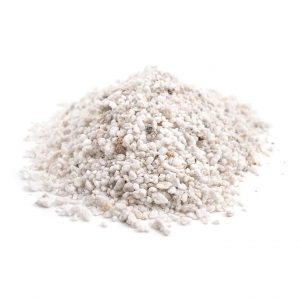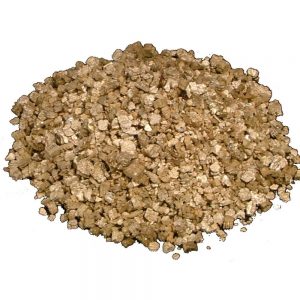Perlite and vermiculite are both used to improve moisture retention and aeration in soil. They are used in a similar manner, but they are not interchangeable. Perlite and vermiculite are quite different in composition and in how they improve your soil. Determining which is better for use in your garden depends on your plants and their needs.
Composition
Vermiculite is an aluminum-iron-magnesium silicate that resembles mica in appearance. For use in horticultural applications, vermiculite is heated to expand the particles. This expansion enables it to absorb moisture when used as a potting medium. Vermiculite can soak up 3 to 4 times its volume in water. It also attracts plant nutrients such as potassium, magnesium, calcium and phosphorus. Perlite is an amorphous volcanic rock that is rich in silicon. When mined for use as a potting medium, perlite is crushed and also heated to expand the particles. The microscopic bubbles in perlite granules absorb and hold water as well, but they also hold air.
Description
Vermiculite is a spongy material that is dark brown to golden brown in color. It is shaped like flakes when dry. Perlite is a porous pumice-like material that looks like white granules. Sometimes perlite is mistaken for tiny plastic foam balls when used in potting soil mixtures.
Water Retention
Perlite and vermiculite are both good at retaining water, but vermiculite acts more like a sponge, holding much more water than perlite and offering less aeration for the plant roots. Perlite retains water because of its large surface area with nooks and crannies available for water storage. Because it is porous it allows excess water to drain more readily than vermiculite and improves soil aeration.
Horticultural Uses
Both vermiculite and perlite are used in the garden to prevent soil compaction, improve aeration and retain moisture. They’re also used in propagation of new plants and seed cultivation, as well as in indoor container growing, composting and on lawns. However, the way that each material retains water, and how much water is retained, makes each one suitable for different plants. Vermiculite is ideal for plants that prefer lots of water, such as forget-me-nots and some irises. Perlite would dry out too rapidly for water-loving plants. However, the amount of water vermiculite holds is not ideal for plants such as cacti or rhododendrons, which need a well-drained soil. The moisture retained by vermiculite would lead to root rots or plant death.
Perlite vs Vermiculite: What’s the Difference?
The difference between perlite vs vermiculite is important to know for the prosperity of your garden. They seem very similar, but differ in a few crucial ways.
What is Perlite?

Perlite
Perlite is lightweight, easy to handle, clean and has no odor. It has a pH of 6.6 to 7.5.
The life of a bag of perlite begins as volcanic glass — but not any type of volcanic glass. It’s formed when obsidian contacts water, creating a unique type of volcanic glass with a high water content. When manufacturers apply heat to perlite, it puffs up into little white balls. Often times they’ll mix these little white balls — what we call perlite — into potting soils to aid with soil aeration and water retention. It retains some water but also air on the surface of the little balls in all the hidden nooks and crannies.
Perlite is a good choice when you have plants in your garden that require soil to dry out completely between watering. For example, if you’re growing a cactus or a succulent, perlite is a great addition to the soil.
Because it’s so porous, perlite does allow excess water to drain quickly…sometimes all over your porch. It has a tendency to easily crush into a powder between your fingers, but this usually isn’t a problem because it doesn’t encounter that type of pressure in your pots or beds. It’s chief use is to improve soil aeration, lightening the soil and giving better drainage and oxygen access for your plants’ roots.
What is Vermiculite?

Vermiculite
Vermiculite interacts with potassium, calcium and magnesium in your soil. It also helps to raise the pH slightly of your plants even though it’s a neutral pH of 7.0.
Vermiculite is made from compressed dry flakes of a silicate material which is absorptive and spongy. The color of vermiculite is a golden brown to a dark brown and is a sometimes difficult to tell from the potting soil it’s mixed with. When water is added to vermiculite, the flakes expand into a worm-like shape and act like an absorbing sponge. If you want to poke these “vermiculite worms” with your fingers, you’re not alone — that’s what I wanted to do when I first saw them too!
Vermiculite is best used for plants that require soil to stay damp and not dry out. For plants that love water, using vermiculite or mixing a healthy scoop of it into your potting soil is the way to go. It can absorb 3 to 4 times its volume when water is added, making your pots a little bit on the heavy side.
Since vermiculite acts like a sponge and absorbs more water than perlite, it doesn’t aerate the soil as well. This means less oxygen for plant roots. If you use it when growing plants that don’t need damp soil, you might find your plants suffering from root rot. So be aware of your plants’ needs when you decide how water retentive you want your soil to be.
More Differences Between Vermiculite and Perlite
There are major differences between vermiculite and perlite, making it important to choose the right one, lest your garden be ruined by a bad growing media choice.
We’ve already covered the biggest difference: Vermiculite will mix with soil and help to retain water. Perlite, on the other hand, will add drainage to the soil that it’s mixed with.
Vermiculite finds its way into many seed starting systems. It both protects seedlings from fungus that so often ruins seed starting, and helps to retain water in the tiny little pods that seeds start in. While perlite can be used with seedlings, it’s better used when you move your seedlings into separate pots for additional drainage.
Which To Use In Your Garden?
There’s a large discussion in the gardening community on which to use in the garden. Here’s the truth: it’s a false debate. They both have their own purposes in the garden.
Use Perlite If…
- You have plants that need to dry out before watering again
- When you move your seedlings to separate pots
- You need to loosen clay soil in your garden
Perlite when added to clay soils, it can eliminate both surface crusting and puddles. It will also help to reduce fluctuations in soil temperatures in your garden soil. Perlite will also improve both drainage and aeration in your home gardens. Horticultural perlite can be bought in different grades according to how you’re going to use it. For general application, a fine to medium grade can be used. It’s free of weeds, disease free and sterile.
Use Vermiculite If…
- You need an additive for plants that need to be kept moist
- You want your seed trays to develop strong seedlings
Vermiculite is odorless, can be purchased in horticultural-grade bags with directions on working it into the garden soil. It’s a permanent soil conditioner and won’t break down in your soil like compost does. When it is watered or it rains, the vermiculite will hold water in the soil until the soil begins to dry out and releases it. Vermiculite can be used in potted containers, on lawns and for composting. It can be used in mycology for mushrooms added to the substrate. It can improve the soil that needs an additive to retain water for your plants which need it.
In summary: Both are good additives to your gardening needs, you just need to know what you’re using them for!